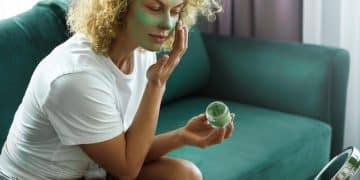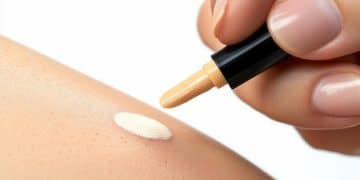The Power of Primer: Flawless Makeup Application Guide
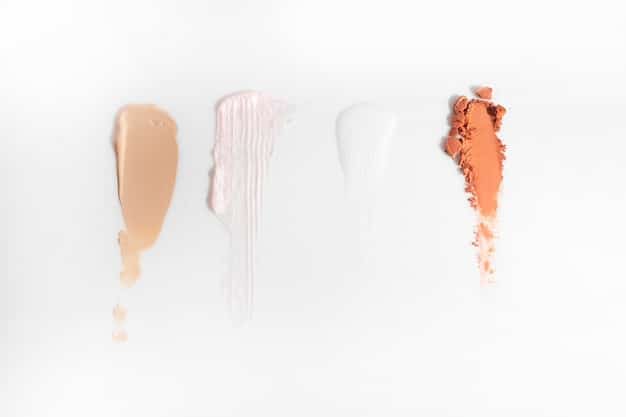
Anúncios
A facial primer is a fundamental step in achieving a flawless makeup application, acting as a crucial barrier between skin and cosmetics to enhance longevity, smooth texture, and unify tone for a polished finish.
In the expansive and often overwhelming world of beauty, certain products stand out as true game-changers, transforming routines from adequate to extraordinary. Among these, the unassuming yet indispensable makeup primer often gets overlooked, despite its profound impact on the final look. This guide delves into The Power of Primer: How to Prep Your Skin for Flawless Makeup Application, exploring its multifaceted benefits and demystifying its role as the unsung hero of your beauty regimen.
Anúncios
Understanding the Foundation: What Exactly is a Primer?
Before diving into the “how-to,” let’s clarify what a primer is and why it holds such a pivotal position in a comprehensive makeup routine. At its core, a primer is a preparatory product applied to the skin (usually after skincare and before foundation) designed to create an ideal canvas for makeup application. Think of it as a base coat for your face, much like a painter prepares a canvas before applying paint.
Primers come in a vast array of formulations, each tailored to address specific skin concerns and desired makeup outcomes. From hydrating and illuminating to mattifying and pore-blurring, the right primer can visibly enhance the performance and longevity of your subsequent makeup layers. It acts as a bridge, smoothing the transition between your skin and your foundation, ensuring a more seamless and professional finish.
The Science Behind the Smooth: How Primers Work
The efficacy of primers lies in their carefully engineered ingredients, which work synergistically to create a refined skin surface. Many primers contain silicones (like dimethicone), which form a smooth, non-greasy barrier that fills in fine lines, wrinkles, and enlarged pores, creating an optical illusion of perfectly even skin. This barrier also helps to prevent foundation from sinking into pores or settling into creases, drastically improving wear time.
Anúncios
Beyond silicones, modern primers incorporate a multitude of active ingredients. For instance, hydrating primers often feature hyaluronic acid or glycerin to draw moisture into the skin, while mattifying primers might contain absorbent powders (like silica or tapioca starch) to control excess oil. Illuminating primers typically use light-reflecting particles or finely milled pearls to impart a subtle glow from beneath the makeup, counteracting dullness. This sophisticated blend of components ensures that a primer doesn’t just sit on the skin but actively treats and prepares it.
- Smoothing Imperfections: Fills in fine lines, pores, and texture, providing an unbroken surface.
- Enhancing Adhesion: Creates a tacky or grippy layer for makeup to adhere to, preventing slippage.
- Controlling Oil/Hydrating: Balances skin’s surface, whether by absorbing oil or adding moisture.
- Extending Wear: Forms a barrier that minimizes makeup breakdown from natural oils and sweat.
Ultimately, a primer isn’t just another step; it’s an investment in the overall success of your makeup look. It ensures that the effort you put into applying foundation, concealer, and other products truly pays off, looking fresh and flawless for hours on end. Ignoring this foundational step can lead to makeup caking, fading prematurely, or emphasizing texture, diminishing the impact of your entire application.
Decoding Your Needs: Choosing the Right Primer for Your Skin Type
Selecting the ideal primer is a highly personalized process, deeply dependent on your unique skin type and specific concerns. A primer that works wonders for someone with oily skin could be disastrous for dry skin, and vice-versa. Therefore, understanding your skin’s characteristics is the crucial first step in harnessing the true power of primer.
For individuals with oily or combination skin, shine control is often a primary concern. Mattifying primers are formulated with ingredients like silica, clay, or salicylic acid to absorb excess sebum, minimize the appearance of pores, and create a soft, velvety finish that keeps shine at bay throughout the day. These primers are designed to extend the wear of makeup by preventing oils from breaking down the foundation.
Conversely, dry or dehydrated skin benefits immensely from hydrating primers. These formulas are typically infused with humectants such as hyaluronic acid, glycerin, and natural oils, which flood the skin with moisture and create a supple, dewy base. A well-hydrated canvas prevents foundation from clinging to dry patches or emphasizing texture, ensuring a smooth, luminous application that feels comfortable and looks natural.
Tailoring Primer to Specific Concerns
Beyond general skin types, many people contend with specific complexion issues that primers can expertly address. For aging skin, primers often contain powerhouse ingredients like peptides, antioxidants, or light-diffusing particles to blur the appearance of fine lines, wrinkles, and provide a more youthful luminosity. These formulas often have a slightly thicker, balm-like texture, offering a comforting and plumping effect.
- Redness-Reducing Primers: Often green-tinted, these primers utilize color theory to neutralize redness from rosacea, broken capillaries, or breakouts, making foundation application more effective.
- Pore-Blurring Primers: Silicone-based and often thicker in consistency, these excel at optically smoothing the skin’s surface by filling in enlarged pores, giving an airbrushed effect.
- Illuminating Primers: Infused with subtle shimmer or pearlescent particles, these add a healthy, radiant glow from within, perfect for dull or sallow complexions.
- Color-Correcting Primers: Beyond green for redness, peach or lavender tones can brighten dullness or counteract sallow undertones, much like a color corrector but with added priming benefits.
The beauty market is saturated with options, making informed choices paramount. Reading ingredient lists and understanding the specific claims of each primer can guide you towards a product that genuinely aligns with your desires. Patch-testing is also highly recommended, especially for sensitive skin, to ensure compatibility and avoid adverse reactions.
Application Mastery: The Art of Priming Your Skin
Once you’ve selected the perfect primer for your needs, the next critical step is mastering its application. While seemingly straightforward, the technique employed can significantly impact the overall effectiveness of the product and, consequently, the final makeup look. Proper application ensures that the primer performs its intended function—creating a seamless, long-lasting base.
Before applying primer, ensure your skin is freshly cleansed, toned, and moisturized. Primer is the bridge between your skincare and your makeup, so it needs a clean, hydrated canvas to adhere to effectively. Give your moisturizer a few minutes to fully absorb into the skin; applying primer too soon can cause pilling or streaking. Patience here is key, as rush can undermine the product’s performance.
Steps for Flawless Primer Application
The amount of primer needed is often less than you might think. A pea-sized amount is usually sufficient for the entire face. Over-application can lead to a heavy feeling, product pilling, or difficulty with subsequent makeup layers. Dispense the primer onto the back of your hand or directly onto your fingertips.
- Warm It Up: If the primer is thick or silicone-based, gently rub it between your fingertips for a few seconds. Warming it slightly can make it more pliable and easier to spread evenly across the skin.
- Targeted Application: Instead of slapping it all over, focus on areas where you need the primer’s benefits most. For oily T-zones, concentrate mattifying primer there. For visible pores, gently press the product into those areas using a patting motion rather than rubbing.
- Even Distribution: Using your fingertips, gently spread the primer evenly across your face. Use light, outward strokes, ensuring complete coverage. Avoid vigorous rubbing, which can disrupt the skin’s surface or cause product to ball up.
- Allow Absorption: This is a crucial, often overlooked step. After applying, allow the primer approximately 60 seconds to fully set and create its barrier before moving on to foundation. This curing time ensures optimal adhesion and prevents mixing with your base makeup.
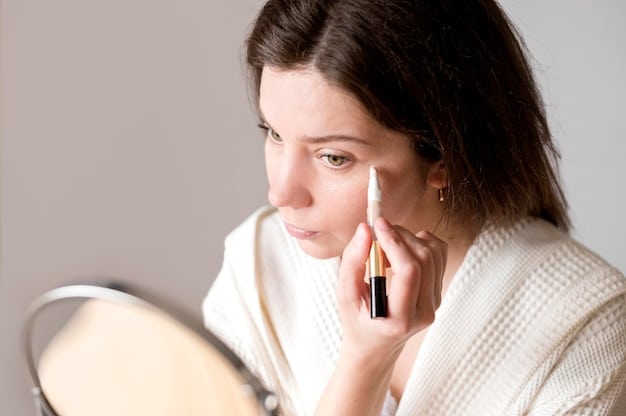
For specific concerns, adjust your technique. If you’re using a color-correcting primer, apply a thin layer only to the areas requiring color neutralization. For illuminating primers, strategically apply to high points of the face (cheekbones, bridge of nose) if you desire a focused glow, or all over for an ethereal luminosity. The goal is a uniform, barely-there layer that preps, rather than coats, the skin. This careful approach optimizes your primer’s benefits and sets the stage for truly flawless makeup.
Beyond the Basic: Advanced Primer Techniques
While the fundamental purpose of primer is to create a smooth, long-lasting base, advanced techniques allow for even greater customization and problem-solving. These methods leverage the unique properties of different primer types to achieve highly specific effects, transforming your makeup from standard to truly professional. Think of these as strategic maneuvers in your beauty arsenal.
One increasingly popular technique is “multi-priming” or “cocktailing” primers. This involves using two or more different primers on various areas of the face to address multiple concerns simultaneously. For example, you might apply a mattifying primer to your oily T-zone (forehead, nose, chin) and a hydrating or illuminating primer to drier areas like the cheeks or under-eyes. This tailored approach ensures that each part of your face receives the specific treatment it needs without compromising on overall balance. It’s a sophisticated way to personalize your base.
Strategic Enhancements with Primer
Primers aren’t just for the face; they can significantly enhance the wear and appearance of makeup in other areas too. Eye primers, specifically formulated for the delicate eyelid skin, are essential for preventing eyeshadow creasing, intensifying pigment, and extending wear. They often have a slightly sticky or tacky finish, creating an ideal grip for powders or creams to adhere to without fading or migrating into fine lines.
- Lip Priming: While less common, specialized lip primers can prevent lipstick feathering or bleeding, especially with vibrant or dark shades. They also create a smoother surface for application, making lip colors appear more vibrant and last longer.
- Spot Priming: Instead of applying primer all over, you can use it only on specific problem areas. If only your nose gets shiny, apply mattifying primer there. If only your under-eyes look dull, a brightening primer can be used exclusively in that zone. This conserves product and avoids unnecessary layers.
- Mixing with Foundation: For a sheerer, more luminous finish, some non-silicone-based illuminating or hydrating primers can be mixed directly with liquid foundation. This can create a custom CC or BB cream effect, perfect for days when you desire lighter coverage with a radiant complexion.
- “Baking” Enhancement: While baking typically involves loose powder, some artists use a small amount of mattifying or blurring primer under the eyes before applying concealer and powder. This super-smooth base can help prevent creasing in an area prone to fine lines.
These advanced techniques demonstrate the versatility of primers. By experimenting with different formulas and application methods, you can unlock new levels of makeup precision and longevity, ensuring your look remains impeccable from morning to night. It’s about leveraging these potent formulas strategically for maximum impact.
The Long-Term Benefits: How Primer Protects Your Skin
Beyond its immediate cosmetic benefits of smoothing texture and extending makeup wear, a well-formulated primer also offers significant long-term advantages for the health and appearance of your skin. It functions as a protective shield, safeguarding your complexion from common environmental aggressors and potential makeup-related issues. This protective aspect is often overlooked but contributes significantly to skin well-being.
One of primer’s primary protective roles is creating a barrier between your skin and your makeup. This barrier is especially beneficial for those with sensitive, acne-prone, or reactive skin. By preventing direct contact between cosmetics and pores, primers can minimize the likelihood of breakouts, irritation, and clogged pores. It acts as a buffer, ensuring the ingredients in your foundation or concealer don’t directly interfere with your skin’s natural balance or trigger sensitivities.
Primer as a Skin Safeguard
Furthermore, many modern primers are enriched with skincare benefits, turning them into hybrid products that treat and protect simultaneously. You’ll find primers boasting antioxidants, vitamins, and even SPF. Primers with SPF provide an additional layer of sun protection, which, while not a substitute for dedicated sunscreen, adds a crucial defense against harmful UV rays – a leading cause of premature aging and skin damage.
- Pollution Defense: Some primers create a physical barrier that helps to repel environmental pollutants from adhering directly to the skin, thus reducing oxidative stress and damage caused by urban environments.
- Moisture Lock-in: Hydrating primers, especially, can help to seal in your skincare, preventing transepidermal water loss throughout the day. This keeps your skin plump, hydrated, and resilient, combating the drying effects of air conditioning or harsh weather.
- Reduced Irritation: By forming a smooth interface, primers can reduce the friction of makeup application and wear, which can be particularly beneficial for delicate or easily irritated skin. This minimizes constant tugging or rubbing throughout the day.
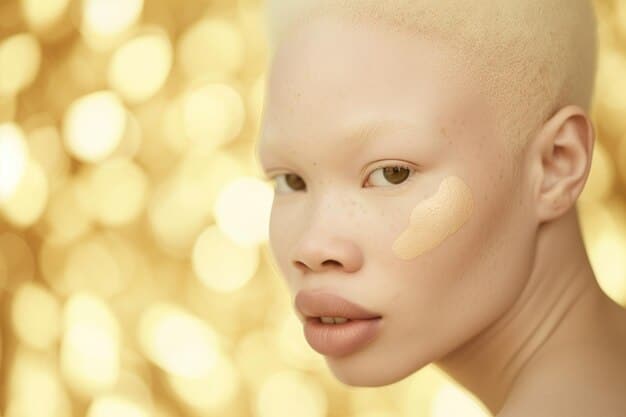
The cumulative effect of these protective measures is healthier, more resilient skin over time. By incorporating primer into your daily routine, you’re not just ensuring a flawless makeup look; you’re actively contributing to the long-term health and vitality of your complexion. This often-underestimated benefit makes primer an indispensable part of a holistic beauty regimen, transforming it from a mere cosmetic enhancement to a genuine skin ally.
Common Pitfalls and How to Avoid Them
Even with the best intentions and the perfect primer in hand, common mistakes in application or product selection can undermine its effectiveness, leading to less-than-flawless results. Understanding these pitfalls and knowing how to circumvent them is essential for consistently achieving professional-looking makeup.
One prevalent mistake is applying too much primer. While the allure of more product equalling more benefits can be tempting, particularly with primers, this often backfires. Excess primer can lead to a tacky or greasy feel, cause subsequent makeup layers to pill or slide off, and create an unnatural, heavy finish. Remember, a little goes a long way; a pea-sized amount is generally sufficient for the entire face.
Troubleshooting Primer Application
Another common error is not allowing the primer enough time to set. Rushing from primer application directly to foundation can cause the products to mix on the skin, disrupting the primer’s barrier effect and leading to patchy or uneven foundation. Giving your primer a minute or two to fully dry and form its film is crucial for optimal performance. This brief pause in your routine ensures the layers work together harmoniously rather than blending into a messy concoction.
- Incorrect Primer for Skin Type: Using a mattifying primer on dry skin or a hydrating primer on oily skin simply won’t yield the desired results and can exacerbate existing issues. Always match your primer to your skin’s primary concerns.
- Product Incompatibility: Not all primers and foundations play well together. Silicone-based primers work best with silicone-based foundations, and water-based primers with water-based foundations. Mixing bases can lead to separation, pilling, or uneven application.
- Applying on Unprepped Skin: Primer isn’t a substitute for skincare. Applying it on dirty, unmoisturized, or un-toned skin will hinder its ability to create a smooth, adherent base. Always begin with a clean, hydrated canvas.
- Rubbing vs. Patting: Vigorously rubbing primer into the skin can cause it to pill, especially silicone formulas. Instead, gently pat or smooth the primer over targeted areas, pressing it slightly into pores or lines.
Ignoring exfoliation can also be a significant oversight. Even the best primer struggles to create a smooth surface over dead skin cells and rough texture. Regular, gentle exfoliation ensures a truly smooth canvas for the primer to work its magic. By being mindful of these common missteps, you can ensure your primer lives up to its full potential, consistently delivering a flawless foundation for your makeup and avoiding frustrating beauty mishaps.
The Future of Primers: Innovations and Trends
The beauty industry is in a constant state of evolution, and primers are no exception. Far from being a static product category, primers are continually being reinvented, driven by advances in cosmetic science, changing consumer demands, and a growing understanding of skin health. The future of primers promises even more sophisticated, multi-functional formulas that blur the lines between makeup and skincare.
One significant trend is the rise of hybrid primers that offer extensive skincare benefits alongside their traditional priming functions. We’re seeing an increasing number of primers infused with potent active ingredients, such as potent antioxidants, ceramides, probiotics, and even gentle retinoids. These formulas are designed not just to prepare the skin for makeup but also to actively improve skin health, texture, and radiance over time. This approach appeals to consumers seeking streamlined routines and products that deliver multiple benefits from a single application, maximizing efficiency.
Emerging Technologies and Formulations
Clean beauty is another powerful driver of innovation in the primer space. Consumers are increasingly seeking products free from parabens, sulfates, phthalates, and synthetic fragrances, leading brands to develop more natural and skin-friendly formulations. This often involves leveraging plant-derived ingredients and innovative bio-engineered compounds that offer similar efficacy to traditional ingredients but with a cleaner profile. The emphasis is on transparency and ingredient integrity.
- Sustainability Focus: Beyond ingredients, sustainable packaging and ethical sourcing are becoming key considerations. Expect to see more refillable primer containers, recycled materials, and formulas with minimized environmental impact.
- Personalization through AI: Imagine primers custom-blended to your precise skin needs, determined by AI analysis of your skin’s condition, environmental factors, and desired makeup finish. This Hyper-personalization is already on the horizon.
- Adaptive Primers: Primers that adapt to changes in skin condition throughout the day, perhaps releasing mattifying agents when oil production increases or hydrating elements when skin feels dry, represent a fascinating future direction.
- “Skinimalism” Influence: The trend towards “skinimalism” (minimal skincare and makeup) means primers will increasingly be expected to provide a perfected, blurred, ‘no-makeup’ look on their own, often with a hint of tint or radiance.
The future of primers is bright, moving towards even more intelligent, responsive, and skin-centric solutions. These innovations promise to make achieving a flawless, long-lasting makeup application easier than ever, while simultaneously nurturing and protecting the skin. As the industry evolves, primers will undoubtedly remain a cornerstone of any truly effective and beneficial beauty regimen, continuously adapting to meet the diverse and dynamic needs of beauty enthusiasts worldwide.
| Key Point | Brief Description |
|---|---|
| ✨ Why Primer? | Creates a smooth canvas, extends makeup wear, and addresses specific skin concerns for a flawless finish. |
| 💧 Skin-Specific Selection | Choose hydrating for dry skin, mattifying for oily skin, and targeted options for concerns like redness or pores. |
| 🎨 Application Secrets | Apply a pea-sized amount evenly, allow it to set for 60 seconds, and use patting motions for best results. |
| 🛡️ Skin Protection | Forms a barrier against makeup and pollutants, often infused with skincare benefits like SPF and antioxidants. |
Frequently Asked Questions About Makeup Primer
A primer is a base product applied after skincare and before foundation, designed to prep your skin for makeup. It creates a smooth canvas, helps makeup last longer by preventing fading or creasing, and can address specific skin concerns like oiliness, dryness, or redness, significantly improving your overall makeup finish.
While not strictly mandatory for everyone, a primer can elevate even everyday makeup significantly. It helps foundation apply more smoothly, reduces the need for touch-ups, and can make your skin look more even and refined. For hot weather or long days, it’s particularly beneficial for maintaining a fresh look.
Identify your primary skin concern: for oily skin, opt for mattifying or pore-blurring primers; for dry skin, choose hydrating or illuminating formulas. If you have combination skin, consider multi-priming different areas. Look for keywords like “oil-free,” “hydrating,” “blurring,” or “radiant” on product labels to guide your choice.
While some primers, especially those heavy in silicones, can potentially clog pores for sensitive individuals if not properly removed, many modern formulas are non-comedogenic and specifically designed to be breathable. Always ensure thorough cleansing at the end of the day and choose “oil-free” or “non-comedogenic” primers if you are prone to breakouts.
Apply a pea-sized amount to clean, moisturized skin using your fingertips. Gently spread it evenly, focusing on areas with concerns (e.g., T-zone for oil, cheeks for dryness). Crucially, allow the primer to set for about 60 seconds before applying foundation. This ensures optimal adhesion and prevents pilling or mixing.
Conclusion
The journey to truly flawless makeup begins well before the first swipe of foundation. As we’ve explored, the humble makeup primer is an indispensable architect of a polished and enduring look, offering far more than just surface benefits. By creating a smooth canvas, enhancing makeup longevity, and providing essential skin protection, primer transcends its role as a mere cosmetic step, solidifying its position as a foundational pillar in any comprehensive beauty regimen. Embracing the power of primer is not just about makeup; it’s about investing in the confidence that comes with a beautifully perfected complexion, setting yourself up for a flawless finish that lasts.




